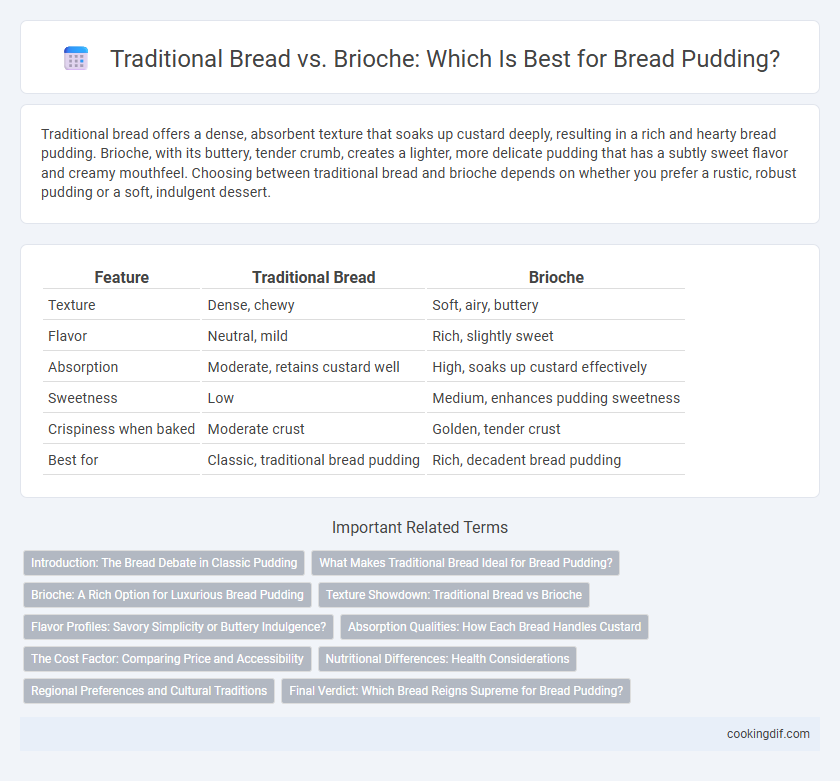Traditional bread offers a dense, absorbent texture that soaks up custard deeply, resulting in a rich and hearty bread pudding. Brioche, with its buttery, tender crumb, creates a lighter, more delicate pudding that has a subtly sweet flavor and creamy mouthfeel. Choosing between traditional bread and brioche depends on whether you prefer a rustic, robust pudding or a soft, indulgent dessert.
Table of Comparison
| Feature | Traditional Bread | Brioche |
|---|---|---|
| Texture | Dense, chewy | Soft, airy, buttery |
| Flavor | Neutral, mild | Rich, slightly sweet |
| Absorption | Moderate, retains custard well | High, soaks up custard effectively |
| Sweetness | Low | Medium, enhances pudding sweetness |
| Crispiness when baked | Moderate crust | Golden, tender crust |
| Best for | Classic, traditional bread pudding | Rich, decadent bread pudding |
Introduction: The Bread Debate in Classic Pudding
Traditional bread, often dense and slightly stale, absorbs custard deeply, creating a rich and hearty bread pudding texture. Brioche, with its buttery softness and subtle sweetness, enhances the dessert by adding a light, tender crumb and delicate flavor profile. Choosing between these breads influences the pudding's moisture retention, flavor complexity, and overall mouthfeel, making the selection essential in crafting classic bread pudding.
What Makes Traditional Bread Ideal for Bread Pudding?
Traditional bread is ideal for bread pudding because its dense, firm texture absorbs custard without becoming overly soggy, ensuring a perfect balance between creaminess and structure. Its staler nature allows it to soak up flavors more effectively, enhancing the pudding's richness and depth. Unlike brioche, traditional bread lacks excessive butter and sweetness, which prevents the dessert from becoming too rich or heavy.
Brioche: A Rich Option for Luxurious Bread Pudding
Brioche's high butter and egg content creates a rich, tender crumb that soaks up custard better than traditional bread, resulting in a creamier, more decadent bread pudding. The slightly sweet, buttery flavor of brioche enhances the overall dessert profile, offering a luxurious alternative to the denser texture of classic bread. Using brioche elevates bread pudding by delivering a moist, flavorful experience that balances richness with a delicate crumb structure.
Texture Showdown: Traditional Bread vs Brioche
Traditional bread provides a dense, sturdy texture that absorbs custard deeply, resulting in a firm yet moist bread pudding. Brioche, enriched with butter and eggs, offers a softer, fluffier crumb that yields a richer, creamier pudding experience. The choice between traditional bread and brioche significantly impacts the final texture, with brioche delivering a more delicate, melt-in-your-mouth quality.
Flavor Profiles: Savory Simplicity or Buttery Indulgence?
Traditional bread in bread pudding delivers a savory simplicity with a neutral crumb that absorbs custard and spices evenly, allowing flavors like cinnamon and nutmeg to shine softly. Brioche offers buttery indulgence with its rich, tender texture and subtle sweetness, intensifying the dessert's decadence and providing a more luxurious mouthfeel. Choosing traditional bread emphasizes balanced, comforting notes while brioche enhances richness and depth, catering to preference for either classic or opulent flavor profiles.
Absorption Qualities: How Each Bread Handles Custard
Traditional bread, such as French or Italian loaf, has a dense crumb that efficiently absorbs custard without becoming overly soggy, creating a balanced texture in bread pudding. Brioche, enriched with butter and eggs, features a tender, airy crumb that soaks up custard richly, resulting in a creamier and more decadent pudding. The choice between traditional bread and brioche significantly affects the final pudding's moisture level and mouthfeel, with brioche providing a luxuriously soft consistency while traditional bread offers structural integrity.
The Cost Factor: Comparing Price and Accessibility
Traditional bread is generally more cost-effective for bread pudding due to its widespread availability and lower price per loaf, making it an economical choice for budget-conscious cooks. Brioche, with its rich ingredients and artisanal production, commands a higher price point that can increase the overall cost of the dish. Accessibility also favors traditional bread, which is easier to find in most grocery stores compared to brioche that often requires specialty bakeries or premium retailers.
Nutritional Differences: Health Considerations
Traditional bread used in bread pudding typically contains fewer calories and less fat compared to brioche, which is rich in butter and sugar. The higher fat content in brioche increases the dessert's overall calorie density, potentially impacting heart health if consumed in excess. Choosing traditional bread can offer a lighter option with lower saturated fat, supporting better nutritional balance in bread pudding recipes.
Regional Preferences and Cultural Traditions
Traditional bread, such as French baguette or Italian ciabatta, is favored in European regions for bread pudding due to its dense texture and ability to absorb custard well, reflecting longstanding cultural baking practices. Brioche, enriched with butter and eggs, is preferred in North American and French cuisine, offering a richer, softer base that creates a more decadent pudding experience aligned with contemporary tastes. Regional preferences influence the choice between these breads, as traditional European recipes emphasize rustic, hearty textures while modern adaptations lean towards the luxurious softness of brioche.
Final Verdict: Which Bread Reigns Supreme for Bread Pudding?
Traditional bread, such as French or Italian loaf, provides a dense, sturdy texture that absorbs custard deeply, resulting in a rich and moist bread pudding. Brioche, with its buttery, tender crumb and slightly sweet flavor, creates a lighter, more decadent dessert that enhances the pudding's richness. For a balanced bread pudding, traditional bread offers structure and custard absorption, while brioche elevates flavor and indulgence, making the final choice dependent on whether texture or richness is the priority.
Traditional bread vs brioche for bread pudding Infographic

 cookingdif.com
cookingdif.com